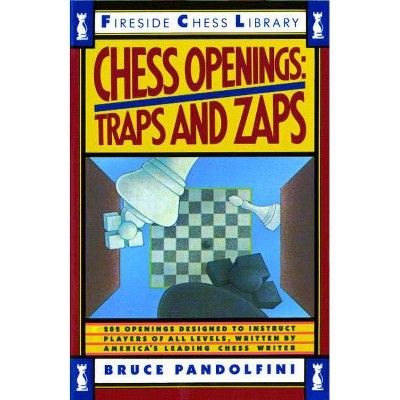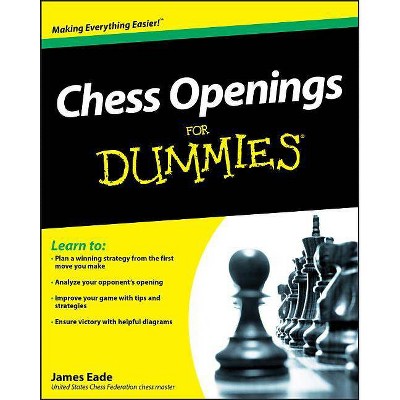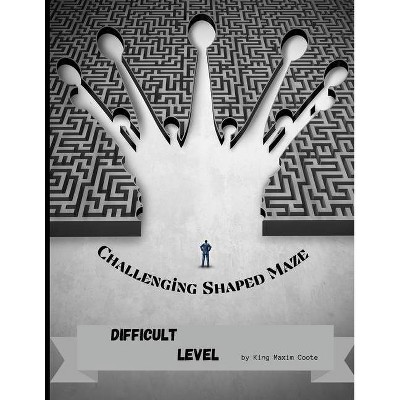Mastering the Chess Openings Volume 2 - by John Watson (Paperback)

Similar Products
Products of same category from the store
AllProduct info
<p/><br></br><p><b> About the Book </b></p></br></br><BR>For many chess-players, opening study is sheer hard work. It is difficult to know what is important and what is not, and when specific knowledge is vital, or when a more general understanding is sufficient. Tragically often, once the opening is over, a player won't know what plan to follow, or even understand why his pieces are on the squares on which they sit. John Watson seeks to help chess-players achieve a more holistic and insightful view of the openings. In his previous books on chess strategy, Secrets of Modern Chess Strategy and Chess Strategy in Action, he explained vital concepts that had previously been the domain only of top-class players. Moreover, he did so in ways that have enabled them to enter the general chess consciousness of club players. Here he does likewise for the openings, explaining how flexible thinking and notions such as 'rule-independence' can apply to the opening. <BR>In this major four-volume work, Watson presents a wide-ranging view of the way in which top-class players really handle the opening, rather than an idealized and simplified model. This volume, focusing on king's pawn openings, is a book that will make chess-players think hard about how they begin their games, while offering both entertainment and challenging material for study in openings such as the Sicilian and Ruy Lopez. <BR><p/><br></br><p><b> Book Synopsis </b></p></br></br>For many chess-players, opening study is sheer hard work. It is difficult to know what is important and what is not, and when specific knowledge is vital, or when a more general understanding is sufficient. Tragically often, once the opening is over, a player won't know what plan to follow, or even understand why his pieces are on the squares on which they sit.<br /><br />John Watson seeks to help chess-players achieve a more holistic and insightful view of the openings. In his previous books on chess strategy, <i>Secrets of Modern Chess Strategy</i> and <i>Chess Strategy in Action</i>, he explained vital concepts that characterize modern chess. Moreover, he did so in ways that have enabled these ideas to be understood by club players. Here he does likewise for the openings, proceeding from the fundamental ideas that apply to all openings to more advanced concepts that are essential for substantial improvement.<br /><br />In this major four-volume work, Watson explains not only the ideas and strategies behind specific openings, but also the interconnections of chess openings taken as a whole. By presenting the common threads that underlie opening play, Watson provides a permanent basis for playing openings of any type.<br /><br />This second volume focuses on queen's pawn openings, exploring such openings as the Nimzo-Indian, King's Indian and the entire Queen's Gambit complex, and the characteristic structures to which they lead.<br /><br />International Master John Watson is one of the world's most respected writers on chess. His groundbreaking four-volume work on the English Opening firmly established his reputation in the 1980s, and he has produced a string of top-quality works since. In 1999, <i>Secrets of Modern Chess Strategy</i>, Watson's first book for Gambit, won the British Chess Federation Book of the Year Award and the United States Chess Federation Fred Cramer Award for Best Book. His former pupils include the 1997 World Junior Champion, Tal Shaked.<p/><br></br><p><b> Review Quotes </b></p></br></br><br>"In his introduction, Watson states that his approach to the book has been to start from the ground and work upwards. He certainly does just that, beginning by explaining the fundamental differences between 1 e4 and 1 d4. Some basic yet important principles and nuances, that can take many players a long time and many games to realize are explained within a couple of pages. Already, the reader is being primed to greater understand the elements of his or her repertoire. Watson then moves on to the more 'meaty' part of the book. ... It is authoratively and pleasantly written, which makes reading it not only productive but also very enjoyable." - John Lee Shaw, chessgateway.com<br><br>"One of the strongest chapters in <i>Mastering the Chess Openings Volume 2</i> is the one on the Queen's Gambit Declined. I particularly liked Watson's treatment of the Exchange variation which he divides into the Carlsbad (Nf3) and Modern (Nge2) variations. Not so long ago White either castled short and played for a minority attack with b4-b5 or castled long and went for a kingside attack. Today add the plan of playing in the center with e3-e4 - sometimes in conjunction with b4 and prophylactic moves like a3 and h3." - IM John Donaldson, jeremysilman.com<br><br>"The book has convinced me entirely! Watson has managed to present the most important openings after 1 d4 and analyses them in detail as well as explaining the backgrounds. When he describes the Sämisch Variation in the King's Indian in nearly 8 pages you have the feeling you are holding a real classic in your hand. It may sound exaggerated, but I believe Watson is a sort of modern Aron Nimzowitsch. Absolutely recommended!" - Martin Rieger, freechess.de<br><p/><br></br><p><b> About the Author </b></p></br></br>International Master John Watson is one of the world's most respected writers on chess. His groundbreaking four-volume work on the English Opening firmly established his reputation in the 1980s, and he has produced a string of top-quality works since. In 1999, <i>Secrets of Modern Chess Strategy</i>, Watson's first book for Gambit, won the British Chess Federation Book of the Year Award and the United States Chess Federation Fred Cramer Award for Best Book. His former pupils include the 1997 World Junior Champion, Tal Shaked.
Price History
Cheapest price in the interval: 20.49 on October 22, 2021
Most expensive price in the interval: 20.49 on December 20, 2021
Price Archive shows prices from various stores, lets you see history and find the cheapest. There is no actual sale on the website. For all support, inquiry and suggestion messages communication@pricearchive.us




















